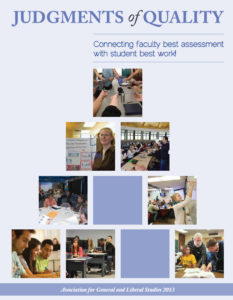Judgments of Quality
 JUDGMENTS of QUALITY: Connecting faculty best assessment with student best work is a 64-page report on the work of nine AGLS institutions from October 2010 through December 2012. Project participants wrestled with the issue of how to do assessment of liberal learning at the highest (about-to-graduate students) undergraduate levels that did not involve any lowering of expectations simply in order to produce data, perhaps even quantitative, for accountability purposes. The idea was to exert intelligence and ingenuity, in order to keep student learning primary to any other concerns from administrators or accreditors.
JUDGMENTS of QUALITY: Connecting faculty best assessment with student best work is a 64-page report on the work of nine AGLS institutions from October 2010 through December 2012. Project participants wrestled with the issue of how to do assessment of liberal learning at the highest (about-to-graduate students) undergraduate levels that did not involve any lowering of expectations simply in order to produce data, perhaps even quantitative, for accountability purposes. The idea was to exert intelligence and ingenuity, in order to keep student learning primary to any other concerns from administrators or accreditors.
There are four chapters in the monograph. The first deals with how to achieve faculty ownership of and investment in such assessments. Chapter Two is a short but insightful treatment of what quickly became the assessment method of choice in the project: the rubric. How rubrics are created (to be valid) and how they can be normed (for the sake of reliability) are the subjects for Chapters Three and Four. A Prologue and an Introduction provide further information on the DNA of the project, and an Epilogue provides some reflections on what participants experienced doing it. For anyone who desires to see further information, there is an appended list of participants with their e-mail addresses.
For a sneak peak, read the Prologue.
To receive your FREE electronic copy of Judgments of Quality, click HERE.
Please be sure to credit AGLS in any references in publications.
Judgments of Quality’s genesis developed out of post-session conversations at conferences between members of AGLS and ACTC. Over time, John Nichols (AGLS) and J. Scott Lee (ACTC) continued to discuss the possibility of the two organizations to develop a project involving multiple institutions for purposes of publishing a monograph exemplifying how assessment would be done successfully without a reliance on scientific, statistical reporting. As Lee envisioned the project in a letter to the AGLS, “The aim of undergraduate general and liberal education is more about capturing the understanding and critical thinking of students, as well as advancing conversations about topics of concern to the arts, cultural and humanist disciplines. More typical forms assessment that rely on scientific tabulations do not effectively capture the entirety of liberal learning.” The project was to create narrative cases that illustrate the stages of learning by students through examples of student work. The result would be assessment not based on answering “how much” but “what” and “how.”
Funding was secured from the Lumina Foundation, Saint Joseph’s College, and anonymous supporters. Two groups of multiple participating institutions were formed, and the work began. Details of the project can be found in the prologue. The Association of Core Texts and Courses’ (ACTC) sister project, Qualitative Narrative Assessment (QNA) is an ongoing project that coincides with the Judgments of Quality monograph.
Be sure also to take a look at our companion piece, Improving Learning in General Education: An AGLS Guide to Assessment and Program Review.
